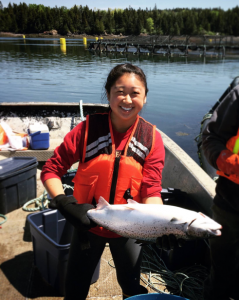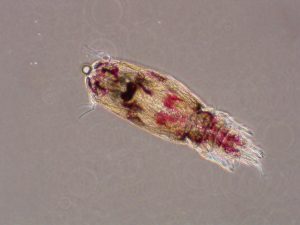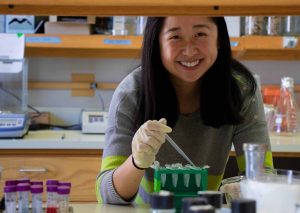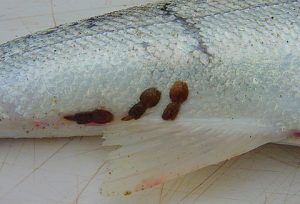Working with Salmon Farmers
SEANET Researchers Hope to Make Sea Lice a Thing of the Past
Liz Theriault, ME EPSCoR Student Writer

One of the biggest challenges faced by the Maine salmon industry comes in the form of a tiny creature. Salmon lice (Lepeophtheirus salmonis) are one species of sea lice, which are parasites that infest both Pacific and Atlantic salmon. These creatures do not grow larger than a dime, yet pose a large threat to the health and longevity of both wild and farm-raised salmon. These parasites attach to the fish using their hooked antennae and frontal filaments and feed on the mucus, blood and skin of the salmon. The attachment of the lice can cause damage to a salmon’s muscle tissue and weaken the immune system. This can make the fish more susceptible to other diseases. In Maine alone, sea lice are estimated to cause the loss of an average of $50 million a year for the salmon industry.
In order to combat this problem, researchers from Maine have been collaborating on a project based at the University of Maine’s Aquaculture Research Institute (ARI). The project was funded by the Sustainable Ecological Aquaculture Network (SEANET), a National Science Foundation Established Program to Stimulate Competitive Research (EPSCoR) grant. This partnership has enabled the development of longstanding research projects to foster a foundational biological understanding of the lice as well as a proactive plan to establish effective preventative vaccines.
When Dr. Ian Bricknell, a United Kingdom native, came to the University of Maine in 2007, he became the first sea lice biologist on campus. Currently, Bricknell is a Professor of Aquaculture at the School of Marine Sciences and now co-leads the SEANET Changing Environments Theme. Over time, Bricknell’s one-man band developed into a seven member faculty powerhouse that has become one of North America’s strongest sea lice research divisions.

The analysis of sea lice specific to Maine’s waters paints a picture of a different kind of life cycle than sea lice in other parts of the world. The extreme cold temperatures and unique water ecosystem has forced the sea lice population that resides here into forming new behaviors in order to survive during the winter months, but what they are doing and how these changes developed remain unclear to researchers. Bricknell and his team are working to understand the biological elements that allow sea lice to thrive here on the coast of Maine.
Bricknell’s first goal with SEANET was to understand whether sea lice use another natural host to survive while they wait for wild salmon to migrate to the area or for farmed salmon to be introduced by aquaculture farmers into the sea water in the spring. In other areas of the world, such as Washington and Oregon on the Pacific coast, or even in British Columbia and Alaska, it was found that sea lice used stickleback fish as a host to complete their life cycle and survive until the salmon enter the waters in May.
However, Atlantic sea lice don’t seem to follow this same strategy. “We looked at maybe 4,000 sticklebacks in Maine, and found only two sea lice,” said Bricknell. “Another group in Newfoundland studied this as well, and they found one more in a slightly larger sample. So studies in the U.S. and Canada show pretty conclusively that they are not using stickleback fish to survive in the Atlantic. So this leaves the question of how do they survive?”
Bricknell and his team hypothesized that the colder temperatures of Maine’s winter waters affect both the quantity and size of eggs produced by sea lice. “Animals have two types of breeding strategies; a K strategy and an R strategy,” said Bricknell. “K strategies are like humans—they put a lot of investment into their offspring but they take a long time to rear and only have a few in their lifetime. R strategies are like rabbits—they have a lot of offspring but put minimal investment in them and work on the principle that some will survive.”
Sea lice have an R strategy, where a single female louse will produce between 500 and 750 eggs every time they spawn. Eggs are typically half to one third of a millimeter in size, but eggs that are released in the cold Maine waters are even smaller.
“It’s almost as if they are going from an R rapid strategy to a super R, super rapid strategy, where they produce even more eggs,” said Bricknell. “The water is so cold that [sea lice eggs] can survive on much less food for a longer time. [The cold] slows down the metabolic rate, and their life expectancy increases.”

Dr. Bricknell and his Ph. D. student, Emma Taccardi, tested this theory by examining the sizes of lipid droplets in sea lice eggs. The lipid droplets are food stores which house enough reserves to keep the newly hatched louse alive until it finds a salmon to attach to. If colder waters can keep these eggs alive longer on smaller amounts of lipid reserves, sea lice could be relying on Maine’s cold temperature to protect their offspring.
Most studies that look at the effects of temperature on sea lice consider sea lice that live in waters with a temperature of four degrees centigrade, which is about the temperature of a refrigerator. In order for sea lice to survive in Maine’s winter waters, however, they would have to survive in minus two degrees Celsius, a chilly 28 degrees Fahrenheit. At four degrees Celsius, studies have shown that sea lice and their eggs can live up to 12 weeks. Bricknell hypothesizes that this time could double to 24 weeks in colder water. If the tests run by Bricknell show that colder waters result in longer life spans of sea lice, then they will have conclusive evidence that Maine’s waters are allowing sea lice to survive over the winter in an egg stage until the return of the salmon in the spring, reducing or even eliminating the need for an intermediate host.
Taccardi’s involvement on this sea lice research project includes working to acquire the foundational biological understanding of the parasites. Comprehending the life cycle of a sea louse allows researchers the ability to find ways to interrupt the growth of the parasite and potentially add new pest management tools to their toolkit.
The ecological, biological and physiological functions of sea lice are the principal drivers of Taccardi’s research. “Understanding the fundamental aspects of the parasite is really crucial to understanding the full life cycle of both wild and farmed salmon… It’s taken us until the past recent handful of years to actually nail down the accurate life stages of the parasite and it’s been around for centuries now,” said Taccardi.” Understanding the biology of sea lice can help researchers decipher the impact a vaccine or treatment will have on the parasite.”
Industry members have numerous creative options for protecting their stock from sea lice. Some may use cement cages that keep the salmon 16 feet or lower below the surface, where sea lice cannot survive; some attempt to change the diet of their salmon to alter the fishes’ natural scents and confuse the parasites; some may set up sea lice traps, to draw the lice away from their farm; and some may use preventative vaccines.

All of these possibilities require sound biological research in order to be effective. However, biological understanding plays the largest part in the development of preventative vaccines. Utilizing a comprehension of the interaction that occurs between the parasite and the host allows vaccine developers to find the most effective formula for halting that interacting and decreasing the number of infected salmon.
Researchers at the Aquaculture Research Institute (ARI) are using the biological parameters of sea lice to develop and test a new line of preventative vaccination to be used by salmon farmers. Debbie Bouchard, director of ARI and research network director for SEANET and her team at ARI recently completed infestation testing at the Aquaculture Research Center (ARC) at the University of Maine. Bouchard, with the help of other sea lice researchers, tested different types of vaccines on a group of salmon taken from Maine’s aquaculture industry stock.
Sea lice remains one of the largest problems faced by the salmon industry. When meeting with stakeholders, researchers reported that for almost eight years in a row industry members have listed sea lice as their number one concern and topic for research. Because of this, SEANET researchers are dedicated to producing the biological understandings that are foundational for vaccine developers to create effective treatments for industry members to protect their farms and produce the healthiest fish.
